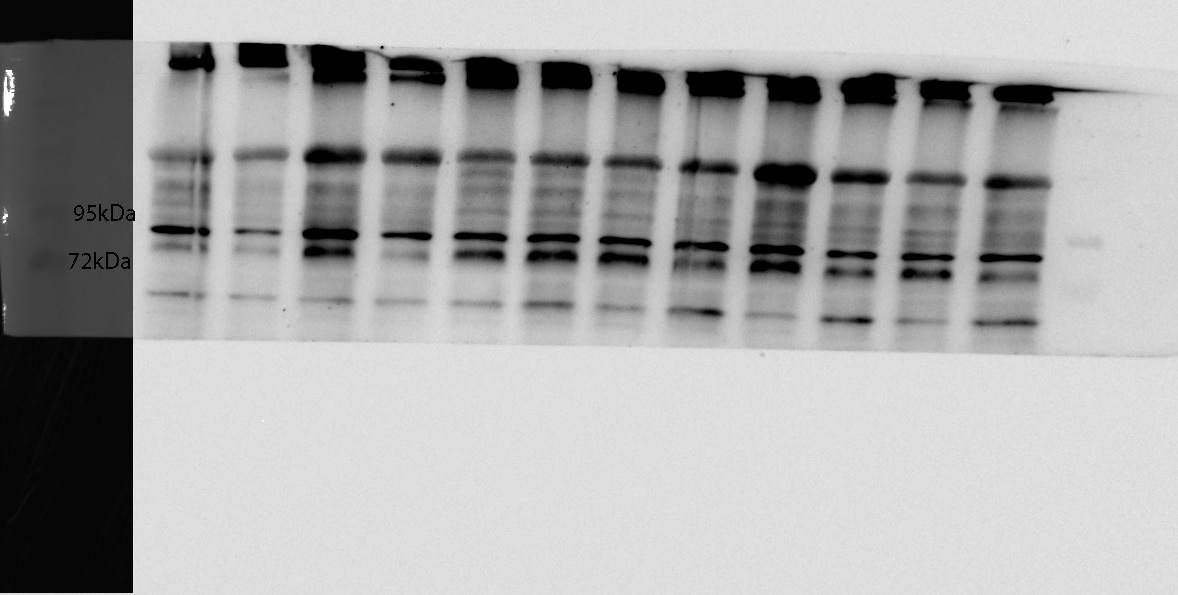Mouse Growth Hormone R/GHR Antibody Summary
Thr25-Gln273
Accession # Q3UP14
Applications
Please Note: Optimal dilutions should be determined by each laboratory for each application. General Protocols are available in the Technical Information section on our website.
Scientific Data
 View Larger
View Larger
Growth Hormone R/GHR in Mouse Liver. Growth Hormone R/GHR was detected in perfusion fixed frozen sections of mouse liver using Mouse Growth Hormone R/GHR Antigen Affinity-purified Polyclonal Antibody (Catalog # AF1360) at 15 µg/mL overnight at 4 °C. Tissue was stained using the Anti-Goat HRP-DAB Cell & Tissue Staining Kit (brown; Catalog # CTS008) and counterstained with hematoxylin (blue). Lower panel shows a lack of labeling if primary antibodies are omitted and tissue is stained only with secondary antibody followed by incubation with detection reagents. View our protocol for Chromogenic IHC Staining of Frozen Tissue Sections.
Reconstitution Calculator
Preparation and Storage
- 12 months from date of receipt, -20 to -70 °C as supplied.
- 1 month, 2 to 8 °C under sterile conditions after reconstitution.
- 6 months, -20 to -70 °C under sterile conditions after reconstitution.
Background: Growth Hormone R/GHR
Growth hormone (GH), also known as somatotropin, is a member of a family of growth factors that includes prolactin, placental lactogens, proliferins and somatolactin (1, 2). It is synthesized primarily by somatotropes in the anterior pituitary and is released as an endocrine hormone. Other cells and tissues, including lymphoid tissues, can also produce GH (3). GH is a pleiotropic molecule which can act directly or indirectly via IGF-I to regulate growth and metabolism as well as enhance T cell survival and thymic functions (1, 2, 4). GH exerts its biological actions by binding to the GH receptor (GHR) that is present in many cell types (1, 2). Mouse GHR cDNA encodes a 650 amino acid (aa) residue type I transmembrane protein with a 24 aa signal peptide, a 249 aa extracellular domain, a 24 aa transmembrane domain, and a 353 aa cytoplasmic domain (5). An alternatively spliced secreted isoform of mouse GHR also exists (6). This variant corresponds to the serum GH‑binding protein. Ligation of GHR by GH has been shown to result in receptor dimerization and activation of the JAK/STAT signaling cascade (7). The soluble GHBP has been shown to interfere with GH signaling by competing with the transmembrane receptor of GH. Alternatively, the GHBP has also been shown to enhance GH action by slowing GH clearance (8).
- Goffin, V. et al. (1996) Endocrine Rev. 17:385.
- Le Roith, D. et al. (2001) Endocrine Rev. 22:53.
- Clark, R. (1997) Endocr. Rev. 18:157.
- Welniak, L.A. et al. (2002) J. Leukoc. Biol. 71:381.
- Smith, W.C. et al. (1989) Mol. Endocrinol. 3:984.
- Edens, A. et al. (1994) Endocrinol. 135:2802.
- Carter-Su, C. et al. (1996) Annu. Rev. Physiol. 58:187.
- Postel-Vinay, M.C. and J. Finidori (1995) Eur. J. Endocrinol. 133:654.
Product Datasheets
Citations for Mouse Growth Hormone R/GHR Antibody
R&D Systems personnel manually curate a database that contains references using R&D Systems products. The data collected includes not only links to publications in PubMed, but also provides information about sample types, species, and experimental conditions.
8
Citations: Showing 1 - 8
Filter your results:
Filter by:
-
Insulin-like Growth Factor 1, Growth Hormone, and Anti-Müllerian Hormone Receptors Are Differentially Expressed during GnRH Neuron Development
Authors: Alyssa J. J. Paganoni, Rossella Cannarella, Roberto Oleari, Federica Amoruso, Renata Antal, Marco Ruzza et al.
International Journal of Molecular Sciences
-
Growth hormone reduces aneuploidy and improves oocytes quality by JAK2-MAPK3/1 pathway in aged mice
Authors: Luo, YY;Zeng, X;Zhu, L;Li, C;Xie, J;Dong, Q;Sun, QY;Huang, GN;Li, JY;
Journal of translational medicine
Species: Mouse
Sample Types: Whole Cells
Applications: ICC -
Molecular interactions of EphA4, growth hormone receptor, Janus kinase 2, and signal transducer and activator of transcription 5B
Authors: T Sawada, D Arai, X Jing, M Miyajima, SJ Frank, K Sakaguchi
PLoS ONE, 2017-07-07;12(7):e0180785.
Species: Mouse
Sample Types: Cell Lysates
Applications: Western Blot -
Growth hormone is increased in the lungs and enhances experimental lung metastasis of melanoma in DJ-1 KO mice
BMC Cancer, 2016-11-08;16(1):871.
Species: Mouse
Sample Types: Cell Lysates
Applications: Western Blot -
Hepatic growth hormone resistance after acute injury.
Authors: Corrick, Ryan M, Li, Li, Frank, Stuart J, Messina, Joseph L
Endocrinology, 2013-02-15;154(4):1577-88.
Species: Mouse
Sample Types: Tissue Homogenates
Applications: Western Blot -
Loss of STAT5 causes liver fibrosis and cancer development through increased TGF-{beta} and STAT3 activation.
Authors: Hosui A, Kimura A, Yamaji D, Zhu BM, Na R, Hennighausen L
J. Exp. Med., 2009-03-30;206(4):819-31.
Species: Mouse
Sample Types: Cell Culture Supernates, Whole Cells
Applications: ICC, Western Blot -
Targeted deletion of hepatic Igf1 in TRAMP mice leads to dramatic alterations in the circulating insulin-like growth factor axis but does not reduce tumor progression.
Authors: Anzo M, Cobb LJ, Hwang DL, Mehta H, Said JW, Yakar S, LeRoith D, Cohen P
Cancer Res., 2008-05-01;68(9):3342-9.
Species: Mouse
Sample Types: Cell Lysates
Applications: Western Blot -
In Vivo Targeting of the Growth Hormone Receptor (GHR) Box1 Sequence Demonstrates that the GHR Does Not Signal Exclusively through JAK2
Authors: Johanna L. Barclay, Linda M. Kerr, Leela Arthur, Jennifer E. Rowland, Caroline N. Nelson, Mayumi Ishikawa et al.
Molecular Endocrinology
FAQs
No product specific FAQs exist for this product, however you may
View all Antibody FAQsReviews for Mouse Growth Hormone R/GHR Antibody
Average Rating: 4 (Based on 1 Review)
Have you used Mouse Growth Hormone R/GHR Antibody?
Submit a review and receive an Amazon gift card.
$25/€18/£15/$25CAN/¥75 Yuan/¥2500 Yen for a review with an image
$10/€7/£6/$10 CAD/¥70 Yuan/¥1110 Yen for a review without an image
Filter by:


